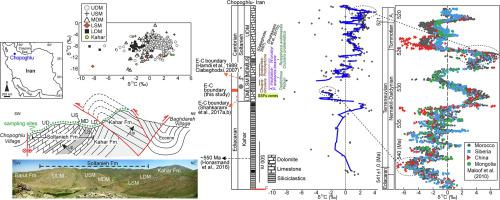Gondwana Research ( IF 7.2 ) Pub Date : 2021-07-06 , DOI: 10.1016/j.gr.2021.07.001 Najmeh Etemad-Saeed 1 , Andrew H. Knoll 2 , Mahdi Najafi 3 , Kristin D. Bergmann 4 , Nicole Haseley 4 , Soroush Karimi 1

|
Mixed siliciclastic-carbonate rocks of the Kahar and overlying Soltanieh formations from Chopoghlu, in the Soltanieh Mountains, northern Iran, preserve an expanded stratigraphic record of Ediacaran to lower Cambrian life and environments. To date, regional placement of the Ediacaran-Cambrian boundary has been based on biostratigraphy, with contrasting views of its stratigraphic position. Here we present a high-resolution carbon isotope chemostratigraphic record to provide an independent assessment of correlation to other successions worldwide. Facies analysis indicates that Kahar siliciclastic sediments accumulated in fluvial to tidal environments, with thin microbial carbonates in tidally influenced facies. The overlying Soltanieh Formation records peritidal carbonate deposition followed by significant deepening and deposition of interlaminated mudstones and thin sandstones. δ13C values for Kahar carbonates, with a maximum age of about 550 Ma, lie within a narrow range of 0 to −2‰, save for a moderate positive excursion near the top of the formation. Above this, carbonates of the Lower Dolomite Member, Soltanieh Formation, show consistently negative δ13C values. The overlying Middle Dolomite, Middle Shale and basal part of the Upper Dolomite members feature high amplitude δ13C variations, which rise to values as high as 4‰ towards the top. Considering the integrated chemostratigraphic and paleontological records, Chopoghlu deposition appears to have begun during the late Ediacaran Period. The stratigraphically variable δ13C record of Soltanieh carbonates closely resembles lowermost Cambrian successions elsewhere, supporting placement of the E-C boundary near the top of the Lower Dolomite Member (LDM) and a Terreneuvian age for overlying Soltanieh beds. This is consistent with the presence of Protohertzina sp. and Hyolithellus sp. in or just above uppermost LDM carbonates and the lowermost occurrence of Treptichnus pedum above this. Together, bio- and chemostratigraphy help to integrate the Chopoghlu section into the global record of biospheric change as the Phanerozoic Eon began.
中文翻译:

伊朗北部 Soltanieh 山脉冈瓦纳埃迪卡拉纪-寒武纪过渡的碳同位素化学地层学
Kahar 的混合硅质碎屑 - 碳酸盐岩和来自伊朗北部 Soltanieh 山脉 Chopoghlu 的上覆 Soltanieh 地层保留了埃迪卡拉纪扩大的地层记录,以降低寒武纪的生命和环境。迄今为止,埃迪卡拉纪-寒武纪边界的区域定位一直基于生物地层学,对其地层位置有不同的看法。在这里,我们提供了高分辨率碳同位素化学地层记录,以提供与全球其他序列的相关性的独立评估。相分析表明 Kahar 硅质碎屑沉积物在河流到潮汐环境中积累,潮汐影响相中含有薄的微生物碳酸盐。上覆的 Soltanieh 组记录了潮间带碳酸盐沉积,随后显着加深并沉积了夹层泥岩和薄砂岩。δKahar 碳酸盐岩的13 C 值,最大年龄约为 550 Ma,在 0 到 -2‰ 的狭窄范围内,除了在地层顶部附近有适度的正偏移。在此之上,下白云岩段 Soltanieh 组的碳酸盐显示出始终为负的 δ 13 C 值。上覆白云岩中段、中段页岩和上段白云岩段基底段δ 13 C 变化幅度较大,向顶部上升幅度高达4‰。考虑到综合的化学地层学和古生物学记录,Chopoghlu 沉积似乎开始于埃迪卡拉纪晚期。地层变量δ 13Soltanieh 碳酸盐岩的 C 记录与其他地方的最低寒武纪序列非常相似,支持 EC 边界位于下白云岩段 (LDM) 顶部附近,以及上覆 Soltanieh 层的 Terreneuvian 时代。这与Protohertzina sp的存在一致。和Hyolithellus sp。在最上层的 LDM 碳酸盐中或刚好在其上方,以及在此之上的Treptichnus pedum的最低位置。随着显生宙开始,生物地层学和化学地层学共同帮助将 Chopoghlu 剖面整合到生物圈变化的全球记录中。















































 京公网安备 11010802027423号
京公网安备 11010802027423号